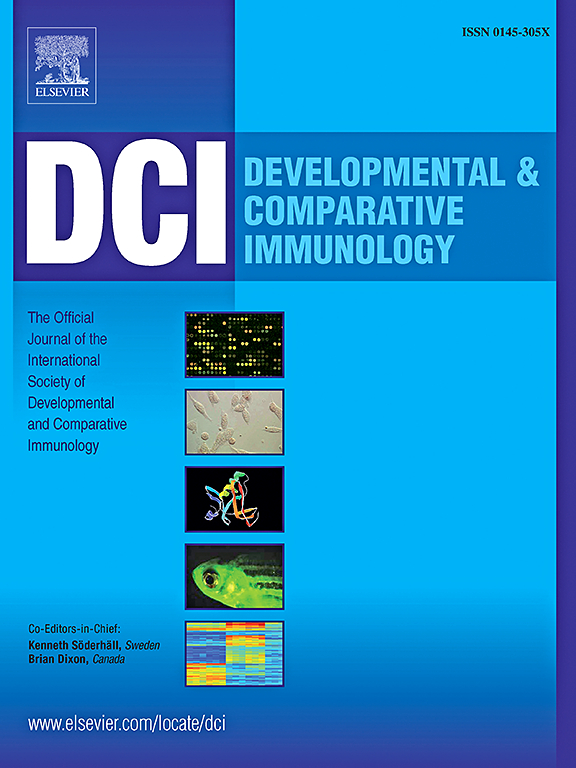A novel complement C1q A chain from marbled flounder, Pseudopleuronectes yokohamae: genome characterization, expression and potential role in antibacterial immunity
IF 2.7
3区 农林科学
Q1 FISHERIES
引用次数: 0
Abstract
This study systematically analyzed the molecular characteristics, tissue expression, and function of the marbled flounder (Pseudopleuronectes yokohamae) C1qA protein (PyC1qA) in fish immunity. PyC1qA contains a signal peptide, collagen-like region, and globular head. Its amino acid sequence and globular structure are highly conserved among multiple species, especially at key sites for pathogen recognition. Phylogenetic analysis showed that PyC1qA has a close evolutionary relationship with other marine fish (such as marbled flounder and European flounder) but is different from freshwater fish. Tissue expression analysis showed that PyC1qA is highly expressed in the skin, and pathogen stimulation experiments showed that its expression changes dynamically in multiple immune-related tissues, indicating that it plays an important role in humoral immunity. Functional studies have shown that recombinant PyC1qA (rPyC1qA) can bind to a variety of fish pathogens and significantly enhance the hemolytic and bactericidal abilities of fish serum. Co-immunoprecipitation experiments verified the specific interaction between PyC1qA and IgM, further supporting its role in regulating humoral immunity through the classical complement pathway. In addition, in vivo experiments showed that rPyC1qA inhibited the proliferation of pathogens in immune-related tissues, demonstrating its potential anti-infection ability. This study revealed for the first time the molecular and functional characteristics of marbled flounder C1qA protein, expanded our understanding of the fish complement system in immune defense, and provided an important theoretical basis for the prevention and control of aquaculture diseases.
一种新的补体C1q A链来自大理石比目鱼,Pseudopleuronectes yokohamae:基因组表征,表达及其在抗菌免疫中的潜在作用
本研究系统分析了大理石纹比目鱼(Pseudopleuronectes yokohamae) C1qA蛋白(PyC1qA)在鱼类免疫中的分子特征、组织表达和功能。PyC1qA含有一个信号肽、胶原样区和球状头。其氨基酸序列和球形结构在多个物种间高度保守,特别是在病原识别的关键位点。系统发育分析表明,PyC1qA与其他海洋鱼类(如大理石纹比目鱼和欧洲比目鱼)有密切的进化关系,但与淡水鱼不同。组织表达分析显示PyC1qA在皮肤中高表达,病原体刺激实验显示其表达在多个免疫相关组织中动态变化,提示其在体液免疫中发挥重要作用。功能研究表明,重组PyC1qA (rPyC1qA)能与多种鱼类病原菌结合,显著增强鱼类血清的溶血和杀菌能力。共免疫沉淀实验证实了PyC1qA与IgM之间的特异性相互作用,进一步支持其通过经典补体途径调节体液免疫的作用。此外,体内实验表明,rPyC1qA抑制了免疫相关组织中病原体的增殖,显示了其潜在的抗感染能力。本研究首次揭示了大理石纹比目鱼C1qA蛋白的分子和功能特征,拓展了我们对鱼类补体系统在免疫防御中的认识,为水产养殖疾病的防治提供了重要的理论依据。
本文章由计算机程序翻译,如有差异,请以英文原文为准。
求助全文
约1分钟内获得全文
求助全文
来源期刊
CiteScore
6.20
自引率
6.90%
发文量
206
审稿时长
49 days
期刊介绍:
Developmental and Comparative Immunology (DCI) is an international journal that publishes articles describing original research in all areas of immunology, including comparative aspects of immunity and the evolution and development of the immune system. Manuscripts describing studies of immune systems in both vertebrates and invertebrates are welcome. All levels of immunological investigations are appropriate: organismal, cellular, biochemical and molecular genetics, extending to such fields as aging of the immune system, interaction between the immune and neuroendocrine system and intestinal immunity.

 求助内容:
求助内容: 应助结果提醒方式:
应助结果提醒方式:


